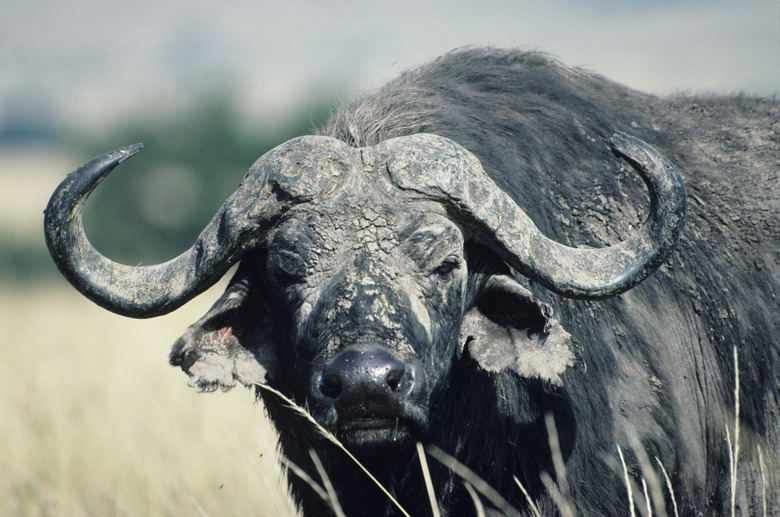The Mozambique Ecosystem
Mozambique is an expansive and elongate country in southeastern Africa, claiming more than 770,000 square kilometers (297,000 square miles). Its eastern coast fronts the Mozambique Channel of the Indian Ocean. From north to southwest, it borders Tanzania, Malawi, Zambia, Zimbabwe, South Africa and Swaziland. Given the latitude and elevations within its bounds, it's no surprise that Mozambique harbors a remarkable spectrum of eastern and southern Africa's defining ecosystems.
Abiotic Ecosystem Factors
Abiotic Ecosystem Factors
Mozambique's physical terrain and soils provide the foundation for its ecosystems, which are further shaped by climatic patterns. Topographically, the country generally increases its altitude westward from the low-lying Indian Ocean coast. The Zambezi River rolling across central Mozambique marks something of a physical boundary. South of its delta, the coastal lowlands extend well inland, while northward, they're substantially narrower. Northern Mozambique belongs to the East African Plateau, which swells to the 2,419-meter (7,936-foot) Mount Namuli on the Mozambican Highland. The other major highlands in the country straddle its northern and western borders along the margin of the Zambia-Zimbabwe Plateau and the Middle Veld. Most of Mozambique experiences a tropical-savanna climate with a rainy season from November to March. The far southwest is subtropical.
Woodlands and Savannas
Woodlands and Savannas
Much of Mozambique is blanketed in savannas and open woodland, ecosystems strongly shaped by extended seasonal drought. Trees of the genus Brachystegia define miombo woodland, which exists in two types in the country. Eastern Miombo Woodland covers much of northern Mozambique's share of the East African Plateau, while Southern Miombo Woodland occupies large tracts of the south. Separating the two, and also stretching southward of the latter, is the generally lower, drier Zambezian and Mopane woodlands, defined by the mopane tree, which is widespread in the Zambezi, Limpopo and Save river valleys.
Savanna Wildlife
Savanna Wildlife
A huge variety of large mammals — ungulates and carnivores — are native to Mozambique's miombo and mopane savannas and woodlands. These include blue wildebeest, Lichtenstein's hartebeest, sable, zebra, impala, common eland, Cape buffalo, reedbuck, greater kudu and warthog. The African bush elephant and southern white rhinoceros, along with the hippo in river courses, are the largest animals in the ecosystem. Lions are the biggest carnivores, hunting in prides to take down nearly any animal in their range. One of Africa's rarest carnivores, the painted hunting dog, persists in Mozambique — notably in the big miombo wilderness of Niassa National Reserve. Other large predators include leopards, cheetahs and spotted hyenas. Smaller ones include caracals, servals, African wildcats and jackals.
Highland Ecosystems
Highland Ecosystems
High grassland, heath, parkland and scattered evergreen forest proliferate where ravines and eastern slopes receive heavy rainfall from maritime air, and define the country's western highlands and scattered interior massifs. These higher-elevation ecosystems harbor organisms that are found nowhere else. The isolated Mount Gorongosa, which looms to 1,863 meters (6,112 feet) inland of the Zambezi delta, is a prime example. Its island-like mountaintop rainforest, receives up to 2,000 millimeters (80 inches) of annual rainfall, and hides such creatures as the Gorongosa pygmy chameleon and a host of unusual insects.
Coastal Ecosystems
Coastal Ecosystems
Large stretches of mangrove swamp predominate along the southern coast and fringing the lower Zambezi and Limpopo rivers. Mangroves are more scattered along the central and northern Mozambican coast, which is regularly battered by tropical cyclones. Mangrove swamps in Mozambique serve as marine nurseries, and often adjoin similarly productive coral reefs and seagrass meadows. The Bazumato archipelago, protected in a national park, is renowned for its rich coral reefs and provides crucial refuge for dugongs, sea turtles and other marine life. Landward of the immediate coast in most of Mozambique lies a belt of maritime woods, savannas, swamps and jungles collectively classed as the Southern Zanzibar-Inhambane Coastal Forest Mosaic. From the vicinity of Xai-Xai south is the subtropical Maputaland Coastal Forest Mosaic.
References
- Encyclopedia Britannica: Mozambique
- The Nature Conservancy: Reef Resilience — Coral Reefs Case Study: Mozambique
- World Geomorphology; E.M. Bridges
- World Wildlife Fund: Ecoregions — Eastern Miombo Woodlands
- World Wildlife Fund: Ecoregions — Southern Miombo Woodlands
- World Wildlife Fund: Ecoregions — Zambezian and Mopane Woodlands
- World Wildlife Fund: Ecoregions — Montane Grasslands and Shrublands
- The National Audubon Society Field Guide to African Wildlife; Peter C. Alden, et al.
- World Wildlife Fund: Ecoregions — East African Mangroves
- World Wildlife Fund: Ecoregions — Maputaland Coastal Forest Mosaic
Cite This Article
MLA
Shaw, Ethan. "The Mozambique Ecosystem" sciencing.com, https://www.sciencing.com/mozambique-ecosystem-7730/. 24 April 2017.
APA
Shaw, Ethan. (2017, April 24). The Mozambique Ecosystem. sciencing.com. Retrieved from https://www.sciencing.com/mozambique-ecosystem-7730/
Chicago
Shaw, Ethan. The Mozambique Ecosystem last modified August 30, 2022. https://www.sciencing.com/mozambique-ecosystem-7730/
